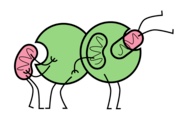A group led by Mara Cirone in Italy found that HHV-6B blocks autophagy in HSB-2 cells. Both HSV-1 and CMV have proteins that block autophagy, and HHV-6B carries genes that are homologues of those encoding for CMV’s anti-autophagy protein. Her next step is to study the impact of both HHV-6A and HHV-6B on autophagy in neuronal cells.
Autophagy, a process of regulated degradation of cellular materials, is important in the elimination of damaged organelles, microorganisms, and otherwise unwanted cellular contents through lysosomal degradation and recycling of usable materials. This process is able to relieve cellular stress, provide cellular energy, and is beneficial to cell survival. Often, the event that triggers autophagy is stress of the endoplasmic reticulum, which may occur upon viral infection. Dysregulation of autophagy has been reported in Alzheimer’s disease (Hamano 2018), cancers (White 2015), and autoimmune conditions (Yin 2018). Now, both species of HHV-6 have been found to affect autophagy in vitro in different ways.
In the present study, HHV-6A-infected HSB-2 cells and HHV-6B-infected Molt-3 cells were assessed after 5 days of infection, when viral protein expression was measured to determine satisfactory extent of infection. Compared to mock-infected cells, expression of LC31/II, a marker of autophagy, was markedly lower in HHV-6B-infected cells. Accumulation of p62, a molecule degraded primarily through autophagy, was also seen, and only a weak presence of autophagosomes was detected in both infected and uninfected cells of the HHV-6B+ culture. In addition, HHV-6B strongly increased expression of the pro-apoptotic endoplasmic reticulum stress molecule CHOP, increased phosphorylation of JNK 1/2, decreased expression of ATF6 f.l., and increased ATF4. In serum taken from children with roseola infantum/exanthema subitum, which is often a manifestation of primary HHV-6B infection, LC31/II was similarly reduced in infected cells compared to mock infected cells, p62 was increased, and markers of endoplasmic reticulum stress were modulated in a manner similar to what was seen in HHV-6B/Molt-3 cultures. Together, the results indicated that HHV-6B infection can inhibit autophagy in vitro and likely in vivo, but increases endoplasmic reticulum stress, thereby leading to cell death.
In contrast, HHV-6A exhibited pro-autophagic activity, with increased LC3/II in the presence of chloroquine in the infected cells, and with accumulation of autophagosomes in infected and bystander cells, although LC3/11 was lower in infected cells than mock infected cells in the absence of chloroquine. In examining the effects of the virus on the unfolded protein response and cell survival, the endoplasmic reticulum chaperone BIP (GRP78), which has a pro-survival effect on cells, was found to be upregulated by HHV-6A. Cell death among HHV-6A-infected cells was lower than among those infected with HHV-6B. Moreover, HHV-6A upregulated phosphorylation of and expression of Ire1 alfa and decreased ATF4, which was consistent with increased autophagy. Previously, HHV-6A-infected astrocytes were found to differentially express 39 genes, including a gene known as CRSS or cathepsin S which is involved in inhibiting autophagy in glioblastoma cells and has been considered as a potential target in treating Alzheimer’s disease (Shao 2016).
In addition to studying whether any homologous gene is at the root of HHV-6B’s inhibition of autophagy, further work measuring endoplasmic reticulum stress responses, autophagy, and cell death in latent HHV-6 infections, rather than lytic infections, would be of interest.
The investigators propose that autophagy could be an important method by which the cell can eliminate unfolded proteins that accumulate during viral replication and thereby relieve itself of metabolic stress and avoid cellular death. Indeed, inhibition of autophagy in cells infected with either virus reduced cell-survival. Going further, the authors suggest that in cases of HHV-6(B)-associated disease, efforts to restore functional autophagy may prove helpful in treating the condition, an idea that has also been put forward in the context of other viral infections (Ke 2018). Several compounds have been found to increase autophagy, including rapamycin (Servante 2018) and spermidine (Puleston 2014), while others, including chloroquine and hydroxychloroquine, inhibit the process.
The authors suggest that the different cellular receptors HHV-6A and HHV-6B use for entry into cells may affect their respective autophagic responses. In the case of measles virus, induction of autophagy has occurred upon engagement of the CD46 receptor.
Both HSV-1 and CMV have proteins that block autophagy, and HHV-6B carries genes that are homologues of those encoding for CMV’s anti-autophagy protein. In addition to studying whether any homologous gene is at the root of HHV-6B’s inhibition of autophagy, further work measuring endoplasmic reticulum stress responses, autophagy, and cell death in latent HHV-6 infections, rather than lytic infections, would be of interest.
Find the full paper here: Romeo 2018.

